The original design of the Internet intended that each host on every network should have a real, routable IP address. An organization that would like to access the Internet would complete some paperwork to describe its internal network and the number of hosts on it. The organization would then receive a number of IP addresses, according to its needs. But there was one huge problem with this concept – if each host on each network in the world was provided with an unique IP address, we would have run out of IP addresses a long time ago!
Therefore, the concept of private IP addressing was developed to address the IP address exhaustion problem. The private IP addresses can be used on the private network of any organization in the world and are not globally unique.
Consider the following example:
In the example above you can see that two unrelated organizations use the same private IP network (10.0.0.0/24) inside their respective internal networks. Because private IP addresses are not globally unique, both organizations can use private IP addresses from the same range. To access the Internet, the organizations can use a technology called Network Address Translation (NAT), which we will describe in the later lessons.
There are three ranges of addresses that can be used in a private network (e.g. your home LAN or office)
- 10.0.0.0 – 10.255.255.255
- 172.16.0.0 – 172.31.255.255
- 192.168.0.0 – 192.168.255.255
Internet routers are configured to discard any packets coming from the private IP address ranges, so these addresses are not routable on the Internet.
Download our Free CCNA Study Guide PDF for complete notes on all the CCNA 200-301 exam topics in one book.
We recommend the Cisco CCNA Gold Bootcamp as your main CCNA training course. It’s the highest rated Cisco course online with an average rating of 4.8 from over 30,000 public reviews and is the gold standard in CCNA training:

